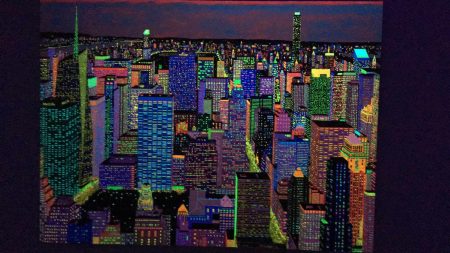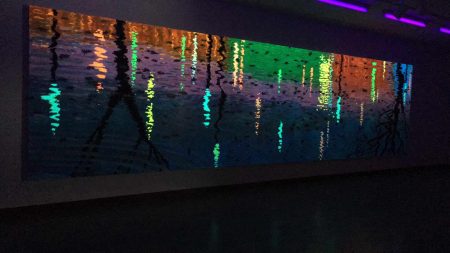Tom Bacher’s Per-40ming Trans-4-ming Phos-4-s-cent Paintings, which is showing at the Weston Art Gallery until June 10, 2018, displays a continuation of Bacher’s hyperrealist quotidian aesthetic re: luminescent paintings that find subjects in object studies, portraiture, and documentation processes. As the two-channel corridor video “Painting with Light” (2018) by YellowHaus Productions elucidates, Bacher’s exhibition implores divinity and the “spiritual self” as well, creating the anthropological bridges of novelist Carlos Castaneda, color theory, and religious iconography/divinity. Bacher’s oeuvre, which has been composed of his stylistic signification – fluorescent and phosphorescent luminescent landscapes and portraits accompanied by lighting effects – has been the subject of fierce criticism by some art critics who, seduced by surface level readings, locate Bacher’s work as “gimmickry” – Luminous Paintings by Tom Bacher, his previous show at the Weston Art Gallery in 2009, was reviewed by CityBeat’s Jane Durrell, who noted the “gimickry” criticism in Bacher’s painting. While Bacher’s body of work readily ascribes stylization vis-à-vis synchronous displays of brilliant colors, earning him notable success in the art market, his work also facilitates metanarratives of divinity and a genealogical “unconcealment” of how light and nature traverse the spiritual self. Perhaps Per-40ming Trans-4-ming Phos-4-s-cent Paintings makes the lesser recognized philosophical and metaphysical facets in Bacher’s work incontrovertibly lucid, as Bacher has honed his focus in this exhibit.
By tying in a 5-minute cycle of dimmed lights to communicate the dual function and ephemera in his work, Bacher’s show poetically reflects materiality and metaphoric narratives. Concurrently apt, Bacher’s fluorescent and phosphorescent acrylics perform a unique dualism where the paints become luminescent after exposure to light by “absorbing and emitting” it (Artists Networks). The lighting displays and references to “coincidental synchronization” facilitate Bacher’s incorporations of time’s passage while object studies and landscapes such as “Maldives Palm Lights” (2018), “New York Freedom Tower” (2012), and “Bryant Park” (2016) place Bacher’s paintings within literal renditions. Much as daily sunsets provide the impetus for urban cityscape phenomena re: glowing windows, street lamps, and neon signs, Bacher’s reflections in “Paper Lanterns Shop” (2017) carry his stylistic leitmotif into a hybrid spiritual realm. For centuries, many cultures have released floating lanterns into the sky in celebration of hopes, wishes, or significant events – Tendai Buddhism’s priest Masako Kuroki equipped her mountain-pilgrimage with paper lanterns to serve as flashlights in the jet-black night sky (Kuroki 380). The transcendence of Bacher’s paper lanterns, which dissolve and foment in the black light/daylight cycle, as well as his subject-choice, provide audiences with multiplicitous readings that extend beyond surface-level understandings of materiality and stylization.
Journalist Sam Quinones’ recent herculean attempt to photograph all of the murals that pay tribute to “The Virgin of Guadalupe” in Los Angeles canvasses the historical practice of lumiscence as a religious motif that captures and restores light in movement via divinity. Quinones notes that the venerated image of “Our Lady of Guadalupe” (the Catholic title of the Virgin Mary, first noted with the “Minor Basilica of Our Lady of Guadalupe” in Mexico City) is often depicted in public settings with an enshrined crown of sun that bridges the Guadalupe and a poignant spiritual affect therewith. Such images and historical practices underlie Bacher’s works as his work with light, emanating from the paintings’ subjects, gradually fades into darkness. It is fitting that Bacher finds inspiration in “glow-in-the-dark” religious iconography. Consequently, Bacher’s works are viewed within the cycle of daylight and blacklight, ushering incorporeal meditation within asomatous case studies.
Bacher’s “deep sense of introspection” is noted in his fascination with Carlos Castenada’s “The Teachings of Don Juan,” a text he often references in artist statements and interviews. In this seminal anthropological text, Castenada offers a new thesis on a mind-state he calls “total freedom” and claims that he used the teachings of his Yaqui shaman (Don Juan) as “springboards into new horizons of cognition” (Castaneda 153). “Don Juan Matus by Rayjmaraca” is a tribute painting by Carlos Castaneda featured in the aforementioned text as an ode to the spiritual guide dubbed Don Juan. The painting sports vermillion and flaxen hypperreal color palettes alongside a cartoonish portraiture. While Bacher’s stylistic penchant may not devolve from Castaneda’s similar painterly praxis, such concordance certainly invites philosophical bridges that explore much more than surface-level readings re: materiality and stylization, which has guided the majority of Bacher’s critical audience. While Bacher may have pigeonholed himself within his leitmotiv stylization, it has been a conscious choice to explore conventional landscapes with unconventional media and transcend the tastes and aesthetic cannons of hyperrealism. Where hyperrealism focused on detailed depictions, Bacher’s painterly abstraction mimics hyperrealism’s spiritual affect but decries its rigid austerity. Selena Reder remarked that in “…the dark, his works are no longer paintings, they are light projections” in the November 2011 AEQAI review of Bacher’s Cincinnati Art Galleries exhibit Fos-4-s-cent Met-A-more-fik Paintings. Bacher’s efforts to convey traces of sensation via ephemera are underscored by those who recognize his consequent metanarratives and technical considerations. Celestial presence and dramatic transformation frame Bacher’s implorations in the divine and human subjectivity.
Bacher does not exhibit any three-dimensional objects in this show, unlike his prior show at the Weston that featured the stepladder Bacher festoons with tape in the course of his art-production – Bacher’s foray into sculpture/installation. Bacher’s reverence towards phosphorescent pigments, paired with his permanence in acrylic, ties Bacher to his media. Hence, there is something qualitatively romantic, humanistic, and Greenbergian in Bacher’s Per-40ming Trans-4-ming Phos-4-s-cent Paintings. The Modernist figurehead art critic Clement Greenberg, Jackson Pollock’s principal champion, lionized the use of characteristic methods of a discipline to criticize the discipline itself, not in order to subvert it but in order to entrench it more firmly in its area of competence (Greenberg 82). Bacher reflects this methodological practice in his decided and honed discipline – phosphorescent acrylic on canvas, which seeks not to criticize the elementary basis of brilliant lumiscent pigments and time’s passage but to elevate these notions with spiritual distinction.
With Bacher, spirituality is a metaphysical narrative that cleverly necessitates bridging via a dual process of Heideggerean unconcealment. Literal unconcealment – a fixture of Bacher’s displays found in his “sunset effects”– is mirrored by a metaphoric unconcealment. Metaphysics conceives of truth as the relationship of correctness between intellect and object; Heidegger points out in “Being and Time” that this conception of truth presupposes the prior disclosure, or unconcealment, of the aesthetic object (120). It is in terms of this “original unconcealment of beings” that Heidegger understands truth in art, which evinces itself through temporal displays – for Heidegger, there exists no postulate and objective “material truth” but, rather, a series of unfolding, connected, and evolving postulates (Duits 21). “Truth as unconcealment” emerges in Bacher’s explorations of the divine in light and Castenada’s spiritual praxes. Bacher’s installation methodologies denote unconcealment at length, motivating a dual function where “two paintings” (one shrouded in blacklight and the other framed by daylight), both divorced and unified, unravel themselves concurrently. As the five-minute lighting cycle continues and foreboding reverent glows trade spaces with rosy auspicious hues, Bacher’s work inherently invites metaphysical bridges.
Bacher’s newest series of water studies are displayed at the Weston Art Gallery, titled “Rainiation 1” (2018) and “Rainiation 2” (2018). These works continue the practice of mixing flourescent red with the phosphorescent glow-in-the-dark paint that Bacher explored in the recent portrait “Marc Nebula” paintings and “Constellation” series. Bacher’s later Eden Park studies – “Eden Park Pond 8” (2017) and “Eden Park Pond 9” (2017) – alongside “Saguaro Lights” (2018) – invite changes in composition and color to divide the fundamental differences between light pigments and conventional color theory. These ominous and shrouded paintings journey into “admixture by subtraction,” the process by which Bacher’s conventional color mixtures evolve into muddy, earthy tones. Bacher has formatted an oeuvre and compositional artistic prowess whereby – regardless of surface reading criticism – his work is unmistakably married to its stylization.
Hence, a Bacher painting is unequivocal and distinctive, which has carried his career, spanning more than fifty years, into numerous solo exhibitions in local, national and international venues. While Bacher’s landmark luminescent skyline murals at the Netherland Plaza Hotel (now the Hilton Cincinnati Netherland Plaza) and local galleries such as Carl Solway Gallery, the Weston Art Gallery, and Cincinnati Art Galleries invite a local presence, it is important to note that Bacher has exhibited internationally at Galerie La Papeterie (Brussels, Belgium) and La Maison des Arts Chatillon (Paris, France). At this later stage of his career, Bacher is decidedly tied to his practice and has honed in on the complexities of materiality, media, and the ephemera. By parsing the spiritual, philosophical, and metaphysical bridges that Bacher’s work forwards, we can move away from surface-level readings and towards underlying syntactic aesthetic narratives.
–Ekin Erkan
Works Cited
Castaneda, Carlos. Teachings of Don Juan: a Yaqui Way of Knowledge. Univ Of California Press, 2016.
Cincinnati Arts. “Tom Bacher: Per-4-Ming Trans-4-Ming Phos-4-s-Cent Paintings.” Cincinnati Arts, www.cincinnatiarts.org/weston-art-gallery/exhibitions/detail/tom-bacher-per4ming-trans4ming-phos4scent-paintings.
Duits, Rufus. “Heidegger and Metaphysical Aesthetics.” Postgraduate Journal of Aesthetics, vol. 1, no. 1, Apr. 2004, pp. 18–24.
Durrell, Jane. “Large and Luminous.” CityBeat Cincinnati, 21 Jan. 2009, www.citybeat.com/arts-culture/visual-arts/article/13018100/large-and-luminous.
“Go for the Glow! | Luminescent Acrylic Paints and Tom Bacher.” Artists Network Staff, Artists Network, www.artistsnetwork.com/art-mediums/acrylic/go-for-the-glow-luminescent-acrylic-paints-and-tom-bacher/.
Greenberg, Clement, and John O’Brian. Clement Greenberg: the Collected Essays and Criticism. University of Chicago Press, ., 1995.
Heidegger, Martin, et al. Being and Time. HarperPerennial/Modern Thought, 2008.
Kuroki, Masako. “A Hybrid Form Of Spirituality And The Challenge Of A Dualistic Gender Role: The Spiritual Quest Of A Woman Priest In Tendai Buddhism.” Japanese Journal of Religious Studies, vol. 38, no. 2, 2011, pp. 369–385. Philosophy Documentation Center.
Quinones, Sam. “Virgin of Guadalupe Archives.” Sam Quinones, www.samquinones.com/tag/virgin-of-guadalupe/.
Reder, Selena. “Transformative Career: Tom Bacher Still Fresh After 36 Years of Luminosity :: AEQAI.” AEQAI, 15 Nov. 2011, aeqai.com/main/2011/11/transformative-career-tom-bacher-still-fresh-after-36-year-of-luminosity/.







